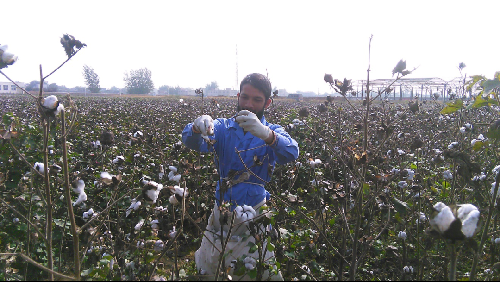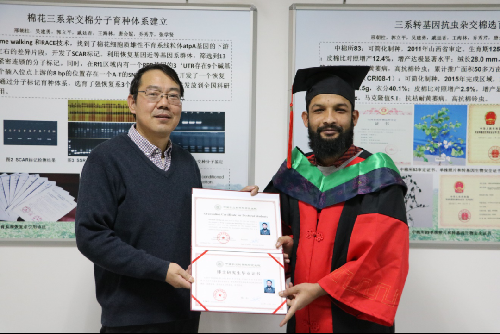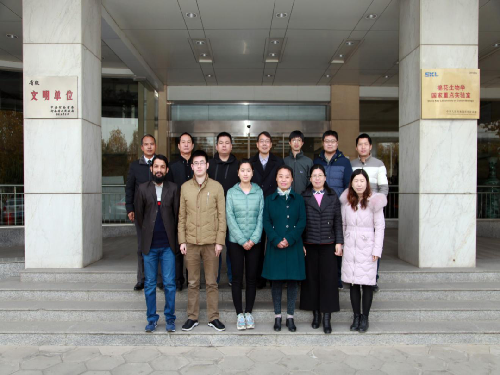- Location : Home» Newsroom
Recent Research Progress: Comparative transcriptome analysis of inbred lines and contrasting hybrids reveals overdominance mediate early biomass vigor in hybrid cotton

Recently, a GSCAAS Ph.D. student Kashif Shahzad under the guidance of Prof. Xing Chaozhu at Institute of Cotton Research, CAAS, Anyang, published an on-line research article entitled “Comparative transcriptome analysis of inbred lines and contrasting hybrids reveals overdominance mediate early biomass vigor in hybrid cotton” in the CAS-Q2 Top journal “BMC Genomics” (IF=3.594). Kashif Shahzad is the first author of this paper, and Prof. Xing Chaozhu and Prof. Wu Jianyong are the co-corresponding authors. Through genome-wide comparative transcriptome analysis, this study revealed that overdominance at gene expression level plays a pivotal role in early biomass vigor. The combinational contribution of circadian rhythm with other metabolic process control early vigorous growth in upland cotton.
Cotton is the prime fiber crop, comprises of more than 50 species, and evolved around 10–20 million years ago. The upland cotton (Gossypium hirsutum L.) has been widely cultivated in tropical and temperate regions of the world, contributing 95% of natural textile fiber, and also a substantial source of edible oil. To mitigate the challenges of food security, a major breakthrough was achieved in rice, maize, sunflower, vegetables, and fruits through heterosis breeding. Manual crossing (emasculation and pollination) is one of the major hurdles causing the sluggish pace of hybrid cotton seed development. The biomass vigor produced during seedling emergence stage has a direct influence on yield heterosis in plants. Unfortunately, the genetic basis of early biomass vigor in cotton is poorly understood.
Three stable performing F1 hybrids varying in yield heterosis named as high, medium and low hybrids with their inbred parents were used in this study. Phenotypically, these hybrids established noticeable biomass heterosis during the early stage of seedling growth in the field. Transcriptome analysis of 42 samples of root and leaf revealed that hybrids showed many differentially expressed genes (DEGs) relative to their parents, while the comparison of inbred parents showed limited number of DEGs indicating similarity in their genetic constitution.
Three stable performing F1 hybrids varying in yield heterosis named as high, medium and low hybrids with their inbred parents were used in this study. Phenotypically, these hybrids established noticeable biomass heterosis during the early stage of seedling growth in the field. Transcriptome analysis of 42 samples of root and leaf revealed that hybrids showed many differentially expressed genes (DEGs) relative to their parents, while the comparison of inbred parents showed limited number of DEGs indicating similarity in their genetic constitution.
Further analysis indicated expression patterns of most DEGs were overdominant in both tissues of hybrids. We found several candidate heterosis genes of circadian rhythm pathway related to Late elongated hypocotyl (LHY), Pseudo-response regulator 9 (PRR9), and CO-like showed downregulated overdominant expressions in both tissues of hybrids. In addition to circadian rhythm, several leaf genes related to Aux/IAA regulation, and many root genes involved in peroxidase activity also showed overdominant expressions in hybrids. Our result provides an important foundation for dissecting molecular mechanisms of biomass vigor in cotton. Furthermore, the further research is currently underway for these genes characterization and functional quantification.
Mr. Kashif Shahzad is a 2017 Spring Semester batch Pakistani international student, graduated in January 2020 from Institute of Cotton Research of CAAS, Anyang, Graduate School of Chinese Academy of Agricultural Sciences (GSCAAS) and received a doctorate in agronomy. His major is Crop Genetics and Breeding, and has worked under the supervision of Prof. Dr. Xing Chaozhu. During PhD, he has published 4 research articles as a first author in BMC Genomics (CAS-Q2 Top, IF=3.594), BMC Plant Biology (CAS-Q2, IF=3.497), Agronomy (CAS-Q3, IF=2.603), and Journal of Cotton Research, with a total Impact factor of 9.694. Furthermore, Kashif has 7 co-authored publications in Journal of Experimental Botany (IF=5.908), International Journal of Molecular Sciences (IF=4.556, two articles), Plant Breeding (IF=1.662), BMC Plant Biology (IF=3.497), Molecular Biology Reports (IF=1.402), and Journal of Cotton Research.

